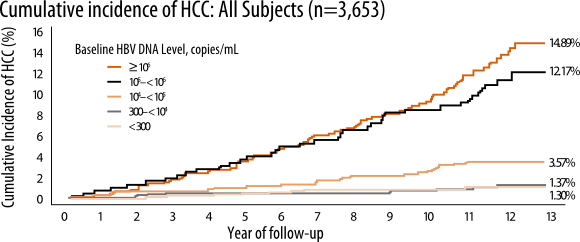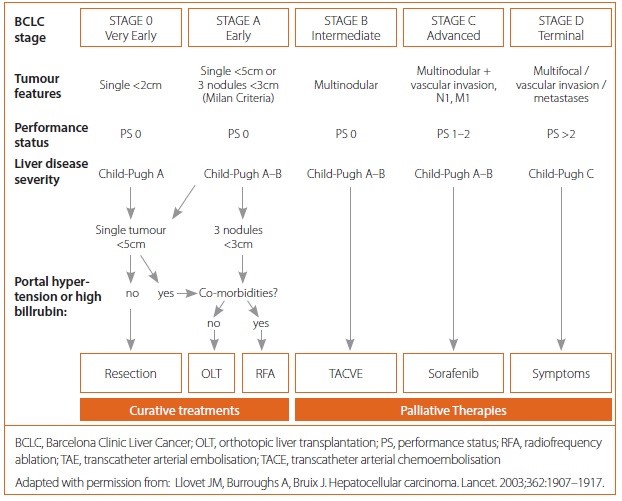KEY POINTS
- Hepatitis B Virus (HBV) is an oncogenic virus that is globally the most important aetiological factor in the development of hepatocellular carcinoma (HCC).
- Treatment of chronic hepatitis B (CHB) decreases, but does not completely eliminate, risk of HCC, underscoring the need for ongoing HCC surveillance in at-risk individuals.
- HCC surveillance by 6-monthly ultrasound scanning, with or without alpha-fetoprotein level is recommended in patients with cirrhosis, and in patients with CHB who have additional risk factors.
- Early diagnosis of HCC improves access to curative therapy and prognosis.
- Curative therapies include liver transplantation, resection and local ablation.
- Additional therapies that prolong survival include transarterial chemoembolisation and sorafenib.
For more information, see: Australian recommendations for the management of hepatocellular carcinoma: a consensus statement.
Click to open Clinical Practice Guidelines for HCC surveillance for people at high risk in Australia recommendations
- Global Burden of Disease Liver Cancer Collaboration. The burden of primary liver cancer and underlying etiologies from 1990 to 2015 at the global, regional, and national level: results from the Global Burden of Disease Study 2015. JAMA Oncol 2017;3:1683-91.
- GLOBOCAN 2020, Estimated age-standardized incidence rates (World) in 2020, liver, both sexes, all ages, [Internet]. International Agency for Research on Cancer; 2022. Available at: http://globocan.iarc.fr (last accessed 29 April 2022).
- The Kirby Institute. HIV, viral hepatitis and sexually transmissible infections in Australia: Annual Surveillance Report 2017 [Internet]. Sydney, Australia: The Kirby Institute; 2017. Available at: https://kirby.unsw.edu.au/sites/default/files/kirby/report/SERP_Annual-Surveillance-Report-2017_compressed.pdf (last accessed 26 June 2018).
- MacLachlan J, Allard N, Carville K, Haynes K, Cowie B. Mapping progress in chronic hepatitis B: geographic variation in prevalence, diagnosis, monitoring and treatment, 2013-15. Aust NZ J Public Health 2018;42:62-8.
- Australian Institute of Health and Welfare 2017. Cancer in Australia 2017. Cancer series no.101. Cat. no. CAN 100. Canberra: AIHW; 2017. Available at: https://www.aihw.gov.au/getmedia/3da1f3c2-30f0-4475-8aed-1f19f8e16d48/20066-cancer-2017.pdf.aspx?inline=true (last accessed 26 June 2018).
- Thein HH, Isaranuwatchai W, Campitelli MA, et al. Health care costs associated with hepatocellular carcinoma: a population-based study. Hepatology 2013;58:1375-84.
- Lang K, Danchenko N, Gondek K, Shah S, Thompson D. The burden of illness associated with hepatocellular carcinoma in the United States. J Hepatol 2009;50:89-99.
- Amin J, O’Connell D, Bartlett M, Tracey E, Kaldor J, Law M, et al. Liver cancer and hepatitis B and C in New South Wales, 1990–2002: a linkage study. Aust NZ J Public Health 2007;31:475–82.
- Seeff LB, Hoofnagle JH. Epidemiology of hepatocellular carcinoma in areas of low hepatitis B and hepatitis C endemicity. Oncogene 2006;25:3771–7.
- Visser O, van Leeuwen FE. Cancer risk in first generation migrants in North-Holland/Flevoland, The Netherlands, 1995–2004. Eur J Cancer 2007;43:901–8.
- Parker C, Tong S, Dempsey K, Condon J, Sharma S, Chen J, et al. Hepatocellular carcinoma in Australia’s Northern Territory: high incidence and poor outcomes. Med J Aust 2014;201:470-4.
- Wan X, Mathews JD. Primary hepatocellular carcinoma in aboriginal Australians. Aust J Public Health 1994;18:286–90.
- Chen CF, Lee WC, Yang HI, Chang HC, Jen CL, Iloeje UH, et al. Changes in serum levels of HBV DNA and alanine aminotransferase determine risk for hepatocellular carcinoma. Gastroenterology 2011;141:1240–8, 8 e1–2.
- Chen CJ, Yang HI, Su J, Jen CL, You SL, Lu SN, et al. Risk of hepatocellular carcinoma across a biological gradient of serum hepatitis B virus DNA level. JAMA 2006;295:65–73.
- Iloeje UH, Yang HI, Su J, Jen CL, You SL, Chen CJ, et al. Predicting cirrhosis risk based on the level of circulating hepatitis B viral load. Gastroenterology 2006;130:678–86.
- Kew MC, Epidemiology of chronic hepatitis B virus infection, hepatocellular carcinoma, and hepatitis B virus-induced hepatocellular carcinoma. Pathol Biol 2010;58:273-7
- Fattovich G. Natural history and prognosis of hepatitis B. Semin Liver Dis 2003;23:47–58.
- De Masi S, Tosti ME, Mele A. Screening for hepatocellular carcinoma. Dig Liver Dis 2005;37:260–8.
- Bosch FX, Ribes J, Borras J. Epidemiology of primary liver cancer. Semin Liver Dis 1999;19:271–85.
- Loomba R, Liu J, Yang HI, Lee MH, Lu SN, Wang LY, et al. Synergistic effects of family history of hepatocellular carcinoma and hepatitis B virus infection on risk for incident hepatocellular carcinoma. Clin Gastroenterol Hepatol 2013;11:1636-45.e1-3.
- El-Serag HB, Richardson PA, Everhart JE. The role of diabetes in hepatocellular carcinoma: a case-control study among United States Veterans. Am J Gastroenterol 2001;96:2462–7.
- Marrero JA, Fontana RJ, Fu S, Conjeevaram HS, Su GL, Lok AS. Alcohol, tobacco and obesity are synergistic risk factors for hepatocellular carcinoma. J Hepatol 2005;42:218–24.
- Yang HI, Lu SN, Liaw YF, You SL, Sun CA, Wang LY, et al. Hepatitis B e antigen and the risk of hepatocellular carcinoma. N Engl J Med 2002;347:168–74.
- Schiff ER. Prevention of mortality from hepatitis B and hepatitis C. Lancet 2006;368 s:896–7.
- Papatheodoridis GV, Lampertico P, Manolakopoulos S, Lok A. Incidence of hepatocellular carcinoma in chronic hepatitis B patients receiving nucleos(t)ide therapy: a systematic review. J Hepatol 2010;53:348-56.
- Papatheodoridis GV, Chan HL, Hansen BE, Janssen HL, Lampertico P. Risk of hepatocellular carcinoma in chronic hepatitis B: assessment and modification with current antiviral therapy. J Hepatol2015;62:956-67.
- Plesch FN, Kubicka S, Manns MP. Prevention of hepatocellular carcinoma in chronic liver disease: molecular markers and clinical implications. Dig Dis 2001;19:338–44.
- Zhang BH, Yang BH, Tang ZY. Randomized controlled trial of screening for hepatocellular carcinoma. J Cancer Res Clin Oncol 2004;130:417–22.
- Heimbach J, Kulik LM, Finn R, Sirlin CB, Abecassis M, Roberts LR, et al. AASLD guidelines for the treatment of hepatocellular carcinoma. Hepatology 2018;67:358-80.
- Wong GL, Chan HL, Tse YK, Chan HY, Tse CH, Lo AO, et al. On-treatment alpha-fetoprotein is a specific tumor marker for hepatocellular carcinoma in patients with chronic hepatitis B receiving entecavir. Hepatology 2014;59:986–95.
- Omata M, Lesmana LA, Tateishi R, Chen PJ, Lin SM, Yoshida H, et al. Asian Pacific Association for the Study of the Liver consensus recommendations on hepatocellular carcinoma. Hepatol Int 2010;4:439–74.
- Digestive Health Foundation. Clinical Update. Australian and New Zealand chronic hepatitis B (CHB) recommendations. Mulgrave, Victoria: Gastroenterological Society of Australia; 2009.
- European Association for the Study of the Liver (EASL), European Organisation for Research and Treatment of Cancer (EORTC). EASL–EORTC clinical practice guidelines: management of hepatocellular carcinoma. J Hepatol 2018;69:182-236.
- Papatheodoridis G, Dalekos G, Sypsa V, et al. PAGE-B predicts the risk of developing hepatocellular carcinoma in Caucasians with chronic hepatitis B on 5-year antiviral therapy. J Hepatol 2016; 64: 800-806
- Parker C, Tong SY, Dempsey K, et al. Hepatocellular carcinoma in Australia's Northern Territory: high incidence and poor outcome. Med J Aust 2014; 201: 470-474.
- Hepatocellular Carcinoma Consensus Statement Working Group. Australian recommendations for the management of hepatocellular carcinoma: a consensus statement. Melbourne: Gastroenterological Society of Australia, 2020. Available at: https://www.gesa.org.au/resources/hepatocellularcarcinoma-hcc-management-consensus/
- Hepatitis B Consensus Statement Working Group. Australian consensus recommendations for the management of hepatitis B infection. Melbourne. Gastroenterological Society of Australia, 2022. Available at: https://www.gesa.org.au/education/clinical-information/hbv-consensus-statement/
- Sherman M. Pathogenesis and screening for hepatocellular carcinoma. Clin Liver Dis 2004;8:419–43, viii.
- Sherman M. Hepatocellular carcinoma: epidemiology, risk factors, and screening. Semin Liver Dis 2005;25:143–54.
- Bolondi L. Screening for hepatocellular carcinoma in cirrhosis. J Hepatol. 2003;39(6):1076–84.
- Wong VWS, Janssen HLA. Can we use HCC risk scores to individualize surveillance in chronic hepatitis B infection? J Hepatol. 2015;63(3):722-32
- Roberts LR, Sirlin CB, Zaiem F, Almasri J, Prokop LJ, Heimbach JK, et al. Imaging for the diagnosis of hepatocellular carcinoma: a systematic review and meta-analysis. Hepatology 2018;67:401-21.
- Llovet JM, Burroughs A, Bruix J. Hepatocellular carcinoma. Lancet 2003;362:1907–17.
- Farinati F, Sergio A, Baldan A, Giacomin A, Di Nolfo MA, Del Poggio P, et al. Early and very early hepatocellular carcinoma: when and how much do staging and choice of treatment really matter? A multi-center study. BMC Cancer 2009;9:33.
- Mazzaferro V, Regalia E, Doci R, Andreola S, Pulvirenti A, Bozzetti F, et al. Liver transplantation for the treatment of small hepatocellular carcinomas in patients with cirrhosis. N Engl J Med 1996;334:693-9.
- Llovet JM. Updated treatment approach to hepatocellular carcinoma. J Gastroenterol. 2005;40:225-35.
- Kawamoto C, Ido K, Isoda N, Nagamine N, Hozumi M, Ono K, et al. Prognosis of small hepatocellular carcinoma after laparoscopic ethanol injection. Gastrointest Endosc 1999;50:214–20.
- Ohnishi K, Nomura F, Ito S, Fujiwara K. Prognosis of small hepatocellular carcinoma (less than 3 cm) after percutaneous acetic acid injection: study of 91 cases. Hepatology 1996;23:994–1002.
- Llovet JM, Ricci S, Mazzaferro V, Hilgard P, Gane E, Blanc JF, et al. Sorafenib in advanced hepatocellular carcinoma. N Engl J Med 2008;359:378–90.
- El-Khoueiry AB, Sangro B, Yau T, Crocenzi TS, Kudo M, Hsu C, et al. Nivolumab in patients with advanced hepatocellular carcinoma (CheckMate 040): an open-label, non-comparative, phase 1/2 dose escalation and expansion trial. Lancet 2017;389:2492-502.
- Kulik LM, Carr BI, Mulcahy MF, Lewandowski RJ, Atassi B, Ryu RK, et al. Safety and efficacy of 90Y radiotherapy for hepatocellular carcinoma with and without portal vein thrombosis. Hepatology 2008;47:71-81.
- Bruix J, Qin S, Merle P, Granito A, Huang YH, Bodoky G, et al. Regorafenib for patients with hepatocellular carcinoma who progressed on sorafenib treatment (RESORCE): a randomised, double-blind, placebo-controlled, phase 3 trial. Lancet 2017;389:55-6.
- Papatheodoridis G, Dalekos G, Sypsa V, et al. PAGE-B predicts the risk of developing hepatocellular carcinoma in Caucasians with chronic hepatitis B on 5-year antiviral therapy. J Hepatol 2016; 64: 800-806
- Parker C, Tong SY, Dempsey K, et al. Hepatocellular carcinoma in Australia's Northern Territory: high incidence and poor outcome. Med J Aust 2014; 201: 470-474.
- Cancer Council Australia Hepatocellular Carcinoma Surveillance Working Group. Clinical practice guidelines for hepatocellular carcinoma surveillance for people at high risk in Australia. April 2023. Sydney: Cancer Council Australia.



